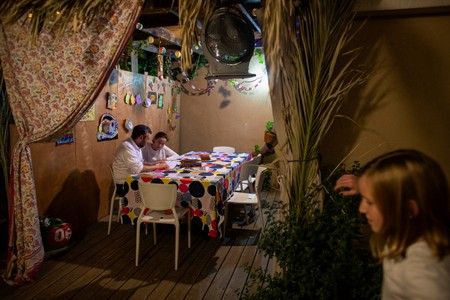Following the loss and destruction of the Holy Temple in Jerusalem in the year 70 C.E., Rabbis decided the Jewish home should be a Mikdash m’at—a “miniature temple”—a holy space where the Shechina (Gd’s Presence) would dwell.
How does one make a Jewish home?
A Jewish home kindles flames to celebrate Shabbos and holidays.
A Jewish home welcomes strangers and makes them friends.
A Jewish home honors and celebrates learning Torah.
A Jewish home is filled with the scent of Jewish food: soups, kugles, gefilte fish, latkes, challah and hamantaschen.
A Jewish home is filled with extended family or friends often.
A Jewish home is filled with stories that have deep meanings—and are source of humor and delight.
A Jewish home is filled with melodies and songs that touch and uplift the soul.
A Jewish home does not turn away from the pain of the day.
A Jewish home shares its blessings.
A Jewish home offers gratitude at meals and makes time and space to nurture family.
A Jewish home cooks meals at important times, and provides food to those celebrating birth, in need of healing and support, and facing loss.
A Jewish home has a tzedakah box in recognition of our blessings and as an obligation to play our part in making the world a better place.
To be sure, there are signs of vitality in Jewish America:
- There’s the continued growth of Jewish Day Schools,
- the rapid spread of Jewish learning and discussion on the Internet and social media,
- the continued growth of the Baal Teshuvah movement—of Jews finding their way back to Judaism
- There is the story of the artist who had become dissatisfied with his work and told his wife, “I’m going out to search for the most important, the most beautiful thing in the world, and that’s the picture I must paint.”
His travels took him far and wide to many countries. He saw many things that were beautiful, but he was not satisfied. He didn’t find what he was looking for. One day he stopped a bride on her wedding day. “Tell me,” he said to the radiant young girl, “what’s the most beautiful thing in the world?”
“Love,” she answered without hesitation.
The artist went on his way disappointed for he couldn’t paint love. Later he met a soldier returning from war. “Soldier,” he said. “What’s the most beautiful thing in the world?”
“Peace,” the soldier answered as he hurried home.
Again, the artist was disappointed for he couldn’t paint peace. Continuing his search he stopped a Rabbi on the way to shul. Surely, he thought, this holy man would be able to help him. But the Rabbi answered simply, “Faith, my son, is the most beautiful thing in the world.”
But how could one paint a picture of faith? The artist felt his search was hopeless and returned home—weary in body and in soul. Then, when his wife warmly greeted him, he found the love of which the bride had spoken. All about his home was the feeling of security, the tranquil peace that the soldier thought so beautiful. And in the eyes of his young children was the faith described by the Rabbi. Here was the subject for his painting—his family and his home! This would be his masterpiece.
My friends, the Jewish home is unique. The Jewish home you create can be your masterpiece. When you enter it you should see mezuzot on the doorposts, Shabbos candlesticks, a Chanukah menorah. There could be Jewish paintings on the walls along with pictures of Jewish celebrations like weddings and Bar/Bat Mitzvahs. And the Jewish home is not only expressed in things, but in opening our homes for guests, for times of joy and sorrow, and for comfort as Abraham and Sarah did…this is the true definition of a Jewish home. Imagine if we could have a home that if Abraham and Sarah showed up they would say, “Now that’s a Jewish home!”









